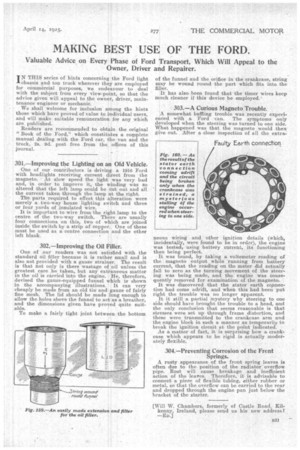MAKING BEST USE OF THE FORD.
Page 15

If you've noticed an error in this article please click here to report it so we can fix it.
Valuable Advice on Every Phase of Ford Transport, Which Will Appeal to the Owner, Driver and Repairer.
IN THIS series of hints concerning the Ford light chassis and ton truck wherever they are employed for commercial purposes, we endeavour to deal with the subject from every view-point, so that the advice given will appeal to the owner, driver, maintenance engineer or mechanic.
We shall welcome for inclusion among the hints those which have proVed of value to individual users, and will make suitable remuneration for any which are published.
Readers are recommended to obt4n the original "Book of the Ford," which constitutes a couiplete manual dealing with the Ford car, the van and the truck, 2s. 9d. post free from the offices of this journal.
301.—Improving the Lighting on an Old Vehicle.
One of our contributors is driving a 1916 Ford with headlights receiving current direct from the magneto. At slow speed the light was very bad and, in order to improve it, the winding was so altered that the left lamp could be cut out and all the current taken through the lamp at the right. The parts required to effect this alteration were merely a two-way house lighting switch and three or four yards of insulated wire.
It is important to wire from the right lamp to the centre of the two-way switch. There are usually four connections on this, two of which are joined inside the switch by a strip of copper. One of these must be used as a centre connection and the other left blank.
302.—Improving the Oil Filler.
One of our readers was not satisfied with the standard oil filler because it is rather small and is also not provided with a gauze strainer. The result is that not only is there wastage of oil unless the greatest care be taken, but any extraneous matter in the oil is carried into the engine. He, therefore, devised the gauze-equipped funnel which is shown in the accompanying illustrations. It can very cheaply be made from an old tin and gauze of fairly fine mesh. The lid should be made long enough to allow the holes above the funnel to act as a breather, and the dimensions given have proved quite suitable.
To make a fairly tight joint between the bottom of the funnel and the orifice in the crankcase, string may be wound round the part which fits into the filler.
It has also been found that the timer wires keep much cleaner if this device be employed.'
303.—A Curious Magneto Trouble.
A somewhat baffling trouble was recently experi. enced with a Ford van. The symptoms only developed when the steering was turned to one side. What happened was that the magneto would then give out. After a close inspection of all the extra neous wiring and other ignition details (which, incidentally, were found to be in order), the engine was tested, using battery current, its functioning then being perfect. It was found, by taking a voltemeter reading of the magneto output while running from battery current, that the reading on the meter did actually fall to zero as the turning movement of the steering was being made, and the engine was consequently removed for examination of the magneto. It was discovered that the stator earth connection had come adrift, and when this had been put right the trouble was no longer apparent. It it still a partial Mystery why steering to one side should have brought the trouble to a head, and the only conclusion that seems reasonable is that stresses were set up through frame distortion, and these were transmitted to the crankcase arm and the engine block in such a manner as temporarily to break the ignition circuit at the point indicated. As a matter of fact, it is surprising how a crankcase which appears to be rigid is actually moderately flexible.
304.—Preventing Corrosion of the Front Springs.
A rusty appearance of the front spring leaves is often due to the position of the radiator overflow pipe. Rust will cause breakage and inefficient action of the leares. Therefore, it is advisable to connect a piece of flexible tubing, either rubber or metal, so that the overflow can be carried to the rear and dropped through the engine pan just below the bracket of the starter.
[Will W. Chambers, formerly of Castle Road, Kilkenny, Ireland, please send us his new address? —En.]






























